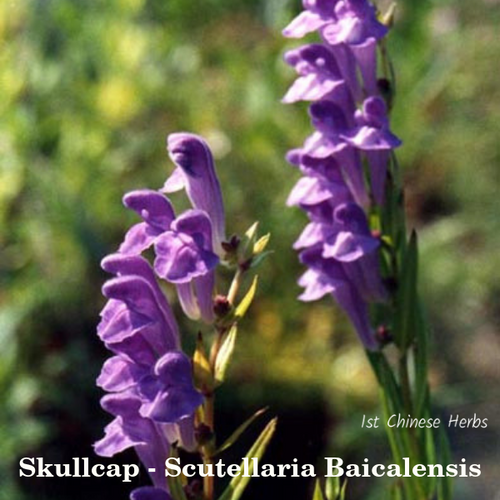Skullcap Root - Scutellaria baicalensis
Posted by 1st Chinese Herbs on Aug 8th 2019
Nature’s Therapeutic Herb
What is Skullcap? Where is it grown?
Skullcap is a flowering perennial plant in the Lamiaceae family with beautiful tubular blue flowers that can be found growing on the grassy and sandy sea shores of Eastern Asia, China, Japan, Korea and Mongolia. Skullcap is also known as Chinese Skullcap and Baikal Skullcap. In traditional Chinese medicine it is call Huang Qin. There are over 200 plants that are referred to as skullcap, therefore, it is important to check the botanical name, Scutellaria baicalensis, to ensure you are using the right herb for your health concerns.
The Ancient Uses of Skullcap: A Fundamental Herb in Traditional Chinese Medicine
The dried root of the skullcap plant is used for medicinal purposes, but the leaves can also be eaten and used in teas. Huang Qin (Skullcap) is considered to be one of the 50 fundamental herbs used in Chinese medicine. It is included in many herbal formulas. Traditionally it clears heat, dries dampness, rids fire, resolves toxicity, cools blood and stops bleeding. Its properties are bitter and cold. The meridians are the stomach, liver, lung and gallbladder.
Health Benefits of Skullcap in Western Herbalism.
In western herbalism skullcap is used for a variety of health concerns. Skullcap is a natural antioxidant with anti-inflammatory, antiviral and antibacterial properties. Studies have shown that skullcap may have anti-tumor and neuroprotective effects. Clinical trials have found skullcap may benefit memory, promotes a positive mood, benefits anxiety, supports cardiovascular health, benefits the liver and promotes a healthy immune system.
A Few
Precautions! Always check with your doctor before starting any new herb.
Do not use skullcap if you are pregnant or nursing. Skullcap may interact with pharmaceuticals, always check with your healthcare provider before starting any herbal treatments. Do not use skullcap with anticonvulsants, barbiturates, benzodiazepines, sleep aid drugs or tricyclic antidepressants.
What herbs can be used in combination with Huang Qin
+Rehmannia Root and Huang Qin
+White Atractylodes and Huang Qin
+Eucommina and Huang Qin
Not Sure How to Use Skullcap? We have this covered too. Methods of using Skullcap.
Dried and cut skullcap root can be used to make a decoction to drink. A tea can be made for a milder dose. Cut pieces may also be used to make a liquid extract for easy dosing. Powdered skullcap is perfect for filling your own capsules. Skullcap does have a bitter and earthy taste but the powdered form can be added to smoothies and your recipes for additional health benefits.
Learn to make your own skullcap extract!
Skullcap & Lyme Disease, as discussed by S. Buhner in “Healing Lyme Disease”
Skullcap is one of the herbs listed in Stephen Buhner’s book “Healing Lyme” and “Healing Lyme Disease Coinfections”. In his books Buhner outlines natural treatments for the effects of Lyme Disease.
Wanting more information on Skullcap?
Interested in skullcap? Click here to see the forms and sizes available at 1st Chinese Herbs.
References
https://en.wikipedia.org/wiki/Scutellaria_baicalensis
https://www.healthline.com/nutrition/skullcap
https://pfaf.org/user/Plant.aspx?LatinName=Scutellaria+baicalensis,
https://www.ncbi.nlm.nih.gov/pmc/articles/PMC5031759/,
https://www.verywellhealth.com/the-health-benefits-of-skullcap-89584,



